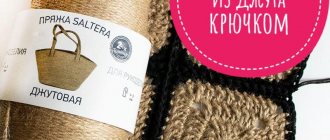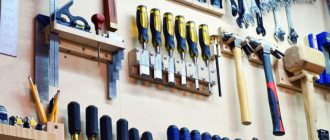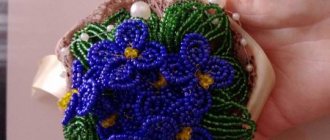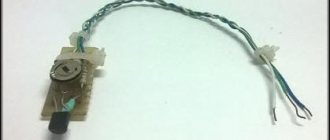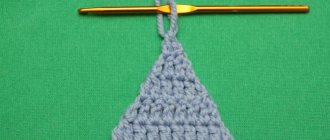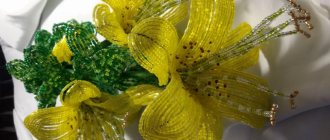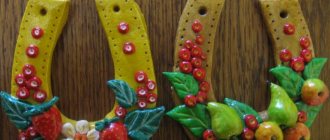Keeping your feet warm, especially in the cold season, is very important, not only for maintaining health, but also for a feeling of coziness and comfort, and therefore spiritual harmony. Not everyone likes to wear slippers at home, and rarely does anyone take them with them when visiting, but soft slippers, also knitted by hand, are an excellent option for home and guest shoes.
Can you knit? Publish your work on knitka.ru
There are many ways of knitting leopards, you can knit them with satin stitch, with a pattern, jacquard and even openwork; the model range also amazes with the variety of shapes. The decoration of the footprints can be anything you want, you can decorate them with knitted flowers, berries or leaves, buttons, children's footprints can be decorated with animal faces.
Yarn for knitting slips should be chosen in accordance with the wishes of the craftswoman, if she knits for herself, or selected to the taste of the person for whom the slips are knitted as a gift. Stiff yarn is not suitable for such a product. For children, children's yarn, hypoallergenic and multi-colored, is best suited, and for men it is worth choosing yarn in discreet shades.
What are footprints for?
No matter how funny these names are, this item of clothing, something between socks and slippers, absolutely seriously performs the main function: keeping your feet warm.
This is the main task of footwear, but recently footwear have appeared that not only warm your feet, but also become an accessory. These are openwork footwear, which can be warm with lace trim or entirely lace.
Why so short?
Most of all, the footprints look like unknitted socks. There are reasons for such “incompleteness”: short ones, covering only the foot and slightly instep of the foot allow you to wear tight-fitting shoes: boots or boots, and also shoes in which the insulating undershirt is either not visible, or also performs a decorative function, often due to lace trim.
The legs sometimes swell due to fatigue or illness. In this case, freedom in lifting the foot is important so that there is no pressure during swelling. And here, footprints with a long heel part and a short one, covering only the toes, come to the rescue. Warm and comfortable.
Product sizing
To determine the size, you need to take the correct measurements from your leg: measure the length, calculate the height of the product, decide how much stock you need to make. The step-by-step algorithm of actions is simple:
- Measure the length and width of your foot with a measuring tape.
- Calculate the height - place your foot on a hard surface and measure along the highest part of it.
- Allow for a margin of 1.5–2 cm (this is exactly how much is needed so that the finished slippers, worn on cotton socks, do not squeeze the foot).
It happens that you don’t have a measuring tape at hand. In this case, you can use a tape measure. If the shoes are intended for a teenager whose feet are growing quickly, there is still no need to make a large supply, otherwise the house shoes will fall off.
What are they: size, material, manufacturing method
Footprints are divided into two large groups: those made only for warmth and those that carry an additional decorative load. Look through the photos of knitted footwear.
Select a plan
The development and implementation algorithm of the project is selected based on scale. Therefore, you need to think carefully about what, how, and how you want to achieve your planned result.
The main problem of knitted footwear
Whatever beautiful model you choose, you will have to solve the problem of abrasion of the sole, because the knitted fabric is quite thin and will quickly become unusable from constant friction. My wool blend socks frayed at the heel after about a month and a half. Undoubtedly, it was pleasant to walk in them, but their life turned out to be very short.
There are several ways to extend the life of knitted footwear or slippers:
- When knitting, add a thick synthetic thread to the main yarn, as our grandmothers did, so that the insole lasts longer.
- Buy special sock yarn for knitting; manufacturers promise that it is much stronger than regular wool blend or semi-synthetic yarn. But its downside is its high cost.
- Use ready-made insoles as soles for knitted footprints, felt or some other.
- Knit a double sole, one of them can be from bags or synthetic cord, jute. You can take some other durable material. The main thing is that the finished footbed insole is not slippery.
Once you have solved the problem with the sole, you can begin choosing a model and description of the footprints. We offer a selection from our readers and needlewomen from the Internet. Good videos - lessons and master classes on knitting leopards for children and adults. We will only crochet.
How does the technique for making slippers with knitting needles differ from slippers?
Most of the technologies for knitting heels are very simple, some of them are similar to the techniques for knitting slippers. Still, you should remember that slippers and footwear are not the same thing. Unlike fairly spacious slippers, slippers should “sit” strictly on the foot and contain a minimum number of seams, or better yet, do without them at all, because they are intended to be worn in shoes. What is the best way to knit them? We will tell you about this in detail. If slippers are not your option, we advise you to study knitting socks with knitting needles with a description, which can be a worthy replacement for even the best socks and slippers!
The simplest seamless heels are knitted on two needles. This can be done easily and simply by following the instructions and diagrams given below.
Decoration
Patterns can be implemented from small to large sizes. First of all, you need to decide on the idea of decoration. Often people use some unobtrusive and cute designs, for example, deer.
True, they don’t quite fit the footprints. In this case, ordinary flowers will be a good option. In case you think this option is trivial, then just try the gradient strategy. Use more than two versions of the color palette.
Knitted clothes are perhaps the most practical and one of the stylish elements of your wardrobe. You can use slippers, Czech shoes, and other types.
Knitting is extremely easy once you learn it. But once you learn, you will be able to create the most beautiful products for yourself and those around you. Handmade gifts will be the ideal gift for loved ones, family and friends.
How to knit footprints with knitting needles
You can knit slips in several ways. They differ in the knitting method and the style of the finished product. A master of any level will be able to find a suitable option.
Knitting followers on two knitting needles
There are several techniques for knitting leopards:
- The beginning of the product is on the toe. In this case, they start with a small number of loops, gradually adding as they expand.
- Start from the top. Knitting begins at the heel and tapers down to the toe.
These techniques are performed without seams, so they will be convenient for beginners. The knitting principle is identical; the choice of method depends on the preference of the knitter.
Step by step description:
- Cast on twenty-four loops and knit with an elastic band in six rows.
- Knit the heel in stockinette stitch for twenty-one stitches.
- Divide the canvas into three equal parts. Purl the first two, knit the last two together.
- Turn the work over and continue knitting in the opposite direction to the central part, knit the last stitch together, turn again.
- Continue attaching the loops of the side parts until only the central one remains.
- Raise eleven stitches on the left and right, picking up the edge stitches on the sides. Knit them. Turn the product over and knit it inside out.
- On the rise in each column, decrease the loops, knitting the last two together. There should be twenty-four left on the knitting needle.
- Knit up to the toe without decreasing.
- Narrow the fabric in the finger area. There should be eight loops left.
- For the upper part of the sock, add loops, connecting them to the edge ones. Knit this way to the heel.
- Connect with the elastic band made at the beginning, secure the thread and cut.
On three spokes
Such heels are knitted into two parts, which are then sewn together. The right and left sides are identical.
Step by step description:
- Cast on 19 stitches and knit with a garter pattern. Add one stitch to each row up to 59. The size of the part is approximately 13 cm.
- At the point of separation, knit 29 stitches using the garter stitch method, cast off one. Place the remaining part on the third knitting needle so that the piece is divided into two halves.
- Work the left side in garter stitch, removing one stitch every other row until 5 remain.
- Knit two knit stitches together. Repeat.
- The next column is knitted.
- Close the piece and trim the thread.
- Do the same on the right side.
- Fold the sock in half and sew the last loops together.
On four spokes
On 4 knitting needles you can make tracks without a seam. Knitting goes in circles.
Step by step description:
- Cast on forty-eight stitches.
- Knit an elastic band, distributing the fabric into equal parts.
- Make seven rows of elastic. Knit two more with a facial pattern.
- Transfer stitches from two adjacent knitting needles to one. Start knitting a straight heel for twenty-two rows.
- Knit the curve of the heel, dividing the fabric into three equal parts and narrowing the sides towards the center.
- Cast on eleven stitches from the side of the heel and knit them with the remaining eight. Knit the stitches so that there are twelve loops left on two knitting needles and fifteen on the others.
- Tie the top. You can use patterns or stockinette stitch.
- At the place of the toe, begin to narrow the work, decreasing the loops through the row.
- Tighten the last loop and cut the thread.
On circular knitting needles
Step by step description:
- Cast on thirty-nine stitches. The exact amount is calculated based on the size of the foot.
- Make 6 rows with an elastic band.
- The top of the foot is knitted in a garter pattern on the central 13 stitches. Knit thirty-four stitches.
- At the toe, narrow the central part. Knit five rows.
- To make a foot, you need to pick up nineteen loops on both sides and knit ten rows.
- Knit the sole in eight stitches, gradually narrowing the work. There should be 51 loops left in the last column.
- Turn the work over to the front side and knit another twenty-six loops.
- Cut the thread and sew open loops.
Children's
Footprints on two knitting needles for beginner needlewomen are a useful and convenient thing for a baby.
Crafts mothers feel much calmer when the child’s feet are warm and comfortable. In addition, it is very pleasant to knit little footprints for your beloved baby with your own hands.
What to prepare:
- a ball of soft yarn (≈200 g);
- 2 straight knitting needles without stoppers, size No. 3;
- hook, size No. 2;
- marker pin, ruler, scissors.
Step-by-step instructions for knitting the simplest tracks:
- Cast on 18 stitches on the needles.
- Knit 60 rows in garter stitch, without tying 1 edge stitch, and purl the last stitch.
- Next, close all the loops with facial loops.
- From the edge braid of the side of the knitted fabric, cast on 32 loops. For ease of work, you can use 3 knitting needles or switch to circular knitting needles.
- Knit a circular fabric with a stocking to the level of the little finger (≈15-25 rows). For this part of the trail, you can use the front surface, openwork, jacquard, pattern with a braid or flagellum.
- Next you need to start decreasing the loops for the spout. Knit knit 1. p., 2 persons. p. in 1 persons. p., 10 persons. p., 2 persons. p. in 1 persons. p., 1 persons. p. According to this pattern, you need to knit the spout of the trail until there are 8 loops left on the knitting needle. Pass the working thread through the remaining loops, tighten and tack.
- Place the side halves of the heel together and sew with a knitted seam.
Next, crochet the finished tracks. You can also crochet flowers, leaves, eyes and faces of animals, bunny ears, pompoms, tassels and anything your imagination suggests.
Footprints on two knitting needles are an excellent knitting school for beginning needlewomen. Experienced knitters claim that having learned to knit small wardrobe items, such as mittens, socks or footwear, you can easily “get your hand” and take on more complex items.
Author: Severyanochka
Article design: Natalie Podolskaya
Openwork
For openwork heels, choose dense threads so that the model ultimately holds its shape well. Below is a description of the knitting pattern for three size ranges: 35/37, 38/40, 41/43, which are suitable for foot lengths of 22, 24, 27 cm. Prepare for the process no more than 1 skein of thread, sock needles 2.5 . So, a diagram with a description with which you can create openwork heels on two knitting needles:
Cast on 57 (57) 61 stitches on two needles. Then switch to knitting in the round. The first line of knitting is knit, the second is purl. Then knit the pattern according to pattern No. 1.
Schematic representation of knitting Knitting the heel, foot and toe
Simple Czech shoes for girls
Beautiful knitted slippers will not be out of place in every girl's wardrobe . When working, it is important to take into account the size of the leg, which will determine the selection of a certain number of loops. For adults, you need to cast on approximately 50 sts. Knit the top with an elastic band - 1x1, 10-15 r. Further:
- Start garter stitch by dividing all stitches into 2 needles and leaving 1 st. in the center;
- knit 1 half, making a yarn over;
- knit the central loop, yarn over;
- knit the second half to the end, knitting the depth of the slipper;
- divide the work into 3 parts, highlighting the middle 10-15 points (this will be the sole);
- knit middle loops, leaving 1 last loop and knitting with the first loop from the second half of the slipper;
- turn the product over and knit again in the same way;
- continue until 15 middle loops are formed;
- knit a few more rows;
- Pull off the remaining loops.
The first loop on the side of the slipper should complete the work.
Deep
Deep footprints are as warm as socks. They are not suitable for wearing in dress shoes, but they are nice to wear at home, and with their help you can show off your beautiful knitting skills to your guests. Below you will find a description of how to knit rainbow trails. There will be one main color, and 2-3 other shades of thread are needed to give the model an interesting shine. Here is a diagram describing deep rainbow traces knitted on two knitting needles:
You will need one skein of yarn in the main color and some threads in rich shades.
Knitting from rows 1 to 16
Also tie a second trail. This model will perfectly decorate your life, especially on gloomy winter evenings.
Multi-colored from leftover yarn
If you knit a lot, then you definitely have leftover multi-colored yarn that you would like to put somewhere. An excellent opportunity for this is to knit the traces on two multi-colored knitting needles from leftover yarn. In the end, it will turn out as if you knitted specifically using the patchwork technique - this is a patchwork knitting technique. Here is a diagram with a description:
Prepare yarn of the same thickness, but different colors. It can be two or more shades. The more colors you combine in one model, the more interesting it becomes.
Knitting squares from leftover yarn Each square is knitted separately Knitting a heel flap
Assembling soles from squares
The trail is ready
Here is another example of how you can knit stylish footwear from leftover yarn - simple, but warm and interesting.
Multi-colored products from leftover yarn
Knitting on two needles
You will need leftover yarn in 2 colors (preferably contrasting), for example, black and red. The work consists of knitting short rows, i.e. in a large semicircle - from heel to heel. For knitting:
cast on 25 stitches;- 1−2 rub. - scarf loops with black yarn;
- 3−4 rub. - 25 p. bright red yarn;
- 5−6 rub. - 25 black loops;
- 7−8 rub. - 15 red loops;
- 9−10 rub. - 25 black loops;
- 11−12 r. - 10 loops of bright red;
- 13−14 r. - 25 loops black;
- 15 rub. - 15 red loops.
Look at the picture to see what happened as a result. As a result, beautiful footprints with a simple pattern are ready.
Herringbone
To create heels with such a pattern, prepare threads of two tones, preferably contrasting ones. It will turn out very stylish and original. These pieces can be worn under winter boots or at home when it gets cold. A diagram with a description that will help you knit the tracks on two knitting needles in a herringbone pattern:
Christmas tree pattern
You will need a little yarn: half a skein of both colors. You will get footprints of size 38. Start knitting like this:
Knitting process
Here is the knitting pattern for the Herringbone pattern:
Schematic representation of the Herringbone pattern
Network
Slippers knitted with a voluminous braided pattern will give you warmth and comfort in the cool season. These slips are knitted from 100 g/160 m wool blend yarn using 4 mm knitting needles.
To work you need to use the following tools:
- Straight knitting needles for knitting a foot.
- Circular knitting needles of the same number.
- 3 mm hook for casting on loops along the edge of the sole.
- An auxiliary needle for making a braided pattern.
- Knitting needle with a blunt end.
Knitting slippers with knitting needles with descriptions and suggested patterns is a pleasure to knit. If you follow these step-by-step instructions, you will get a pair of sizes 36-39.
Knitting should start from the sole (this part must be done the same for the left and right slippers):
- In the classic way, you need to cast on 8 loops on straight knitting needles and knit 2 rows. (knit all stitches).
- In rows 3, 5 and 7 you need to increase: knit 1, knit the next one. for each wall (2 loops from one), then you need to knit until there are 2 loops on the knitting needle, increase again, knit the last stitch. After completion of 7 p. there will be 14 loops on the knitting needle.
- Rows 8-42 must be knitted with a garter pattern.
- In the 43rd row, you again need to make 2 increases according to the same principle as before; there will be 16 loops on the knitting needles.
- Rows 44-74 need to be knitted with knit stitches.
- In rows 75, 79 and 81, it is necessary to decrease the loops to shape the sole: knit 1, knit 2 together, then knit all the loops until there are 3 loops left in the row, knit 2 together, knit 1. After all the decreases, there will be 10 stitches left on the knitting needle.
- Knitting the sole is completed after completing 82 rows; close the loops in a convenient way.
- Using a crochet hook, pick up 99 stitches along the edge of the sole, gradually transferring them onto circular knitting needles. Then knit the installation row of faces. P.,
- Sides should be up to 8 p. knit with elastic band 2 * 2, last loop purl.
- At 9 p.m. requires knitting alternating 2 persons. and 2 out. 12 times, k2 together, p2, again alternating k2, p2. 11 times, k2, p1. There should be 98 stitches on the needles in total.
1st row: you need to alternate the elastic band 2 by 2, starting with the front ones - 10 times, 18 knits, 2 knits together. with a tilt to the left, then you need to turn the work. 2nd row: 1 loop needs to be removed without knitting, 18 purl loops, 2 purl stitches together, perform a knitting turn. Similarly, all purl rows up to 44 inclusive should be knitted.
From rows 3 to 43 you need to make a braided pattern according to the diagram. Slip 1, knit 1, cross 4 loops to the right (4 times), knit 1, knit 2 together with a slant to the right. Row 5: 1 loop must be removed, knit 18, knit 2 together with a slant to the left. Row 7: you need to slip 1 stitch, knit 3, cross 4 stitches to the left 3 times, knit 3, knit 2 together. with a tilt to the left.
In the 9th row, remove the first loop, knit 18 knit stitches, 2 knit stitches together, tilted to the left. Rows 11, 13 and 15 must be knitted similarly to rows 3, 5 and 7, respectively. Next, you need to repeat knitting rows 9-16 3 more times (in total, 40 rows should be knitted from the beginning of knitting the upper part).
Knitting 41 rows must be done identically to row 9, and then repeat rows 2, 3 and 4 once. There should currently be 54 stitches on the needles. The next 10 rows (45-54) are knitted using all loops. Row 45: 1 loop must be removed, knit 19, purl 2, alternating 2 knits 3 times. and purl 2, knit 2, purl 1.
In the 46th row *8 times you need to alternate 1 knit, 1 purl*, knit 22 purls, repeat **. Row 47 must start with **, knit 5, cross 4 stitches to the left 3 times, knit 5, and repeat ** again. Rows 48, 50 and 52 should be knitted identically to row 46. Row 49: you need to knit **, 22 knit stitches, **.
In the 51st row you need to knit **, 3 knit stitches, cross 4 times 4 loops to the right, 3 knit stitches, **. The 53rd and 54th rows should be knitted, then bind off all the loops and sew a back seam using a knitting needle.
Seamless option
Sleeves on two knitting needles without a seam are suitable for beginner knitters and for those who are mastering the skill of knitting hosiery. A version of footwear without a seam is a quick and very simple production of footwear with a beautiful openwork pattern on the front or sides.
For knitting you need to prepare:
- 200 g of any yarn (or leftovers from other knitting);
- set of 2 straight knitting needles without stoppers (size depends on thread thickness);
- marker pin;
- ruler, scissors.
Technology for knitting footwear on 2 knitting needles without a seam:
- Cast on 30 stitches on paired needles and knit 6 rows with knit stitches - this is the thickened edge of the heel.
- Next, from rows 7 to 22, you should knit the fabric with stockinette stitch. That is, knit all the loops on the front side with knit stitches, and on the wrong side with purl stitches.
- From row 23 to row 41 – heel formation. Knit 19 stitches, and knit the next 2 stitches together with 1 knit stitch. Then you need to turn the work over, purl 9 stitches and make the next 2 loops together with 1 purl loop. Turn the knitting over again and repeat this knitting pattern until there are only 10 stitches left on the knitting needle.
- In the 42nd row, cast on 10 stitches from the edge braid on the side of the heel and turn the knitting over.
How to knit slips on two knitting needles for beginners: model of slips without a seam
- Row 43 – knit 20 stitches, and then again cast on 10 stitches from the edge braid on the side of the heel. As a result, there should be 30 loops per heel volume.
- From rows 44 to 74 you need to knit the fabric of the sling using stockinette stitch without decreasing or casting on loops.
- From the 75th row you need to start decreasing. Knit 7 knit stitches, then 3 knit stitches, then 10 knit stitches, again 3 knit stitches and 7 knit stitches.
- Row 76 is knitted with purl stitches.
- Row 77 – knit 6 knit stitches, 3 knit stitches, 8 knit stitches, again 3 knit stitches and 6 knit stitches.
- Row 78 – purl all stitches.
- Row 79 – 5 knit stitches, 3 knit stitches, 6 knit stitches, 3 knit stitches and 6 knit stitches.
- Row 80 – purl all stitches.
- 81 rows – 4 knit loops, 3 knit loops, 4 knit loops, 3 knit loops and 4 knit loops.
- Row 82 – purl all stitches.
- Row 83 – 3 knit loops, 3 knit loops, 2 knit loops, 3 knit loops and 3 knit loops. At this stage of knitting there should be 9 loops left on the knitting needle.
- Row 84 – purl 9 loops, and pull the next 10 loop from the edge braid. On each side of these loops you need to cast on 18.
- Row 85 – 4 knit stitches, 3 knit stitches, 3 knit stitches and 1 edge braid loop.
- Row 86 is knitted in the same way as row 84.
- Row 87 is the same as row 85.
Next, you need to alternately knit patterns of 84 and 85 rows until all the loops of the edge braid are completed. At the end of knitting, close the remaining 9 loops with facial loops.
Slippers with cones
Knitted slippers, the knitting description of which can be found in this material, are decorated with an interesting three-dimensional pattern of braids and cones.
The basis for calculating the loops of such a pair of slippers should be taken from the description of the previous model, changing the main garter stitch pattern to a “rice” pattern, and replacing the toe pattern with the proposed decor according to the diagram.
Knitting leopards with cones includes several stages:
- Knitting the heel fabric.
- Adding loops from the side edges of the heel.
- Knitting the main fabric of the leotka.
- Decreasing stitches in the toe section.
- Knitting the upper decorative part according to the pattern.
- Knitting a second slipper.
For indoor slippers size 38-39 you will need approximately 60 g of yarn 100 g / 240 m.
Simple followers for beginners
Size: 37.
To connect this model we need:
- yarn, 100% wool, carrot color – 80g;
- a little of the same yarn, white - for tying;
- knitting needles No. 4;
- hook No. 3 or needle with a large eye.
Pattern:
- shawl pattern: all loops in all rows. – facial.
Density: in the shawl pattern 15p. equal to 10cm.
How to link followers
This model for beginners is made in one piece using a scarf pattern.
For the followers we cast on with knitting needles 15 sts. and knit 28r. Then on the right edge we additionally dial 30p. and continue general knitting for another 28 rubles. Next row on the right edge close 15 p. and at the same time on the left edge we dial an additional 15 points. We continue to 28 rubles. straight knitting. Then close P.
Assembly of followers
We sew the traces, guided by the instructions in the diagram. Alignment points: A-A, B-B, C-C, DD, E-E. We crochet the edge of the product with white yarn. If you wish, you can simply stitch it using a needle with a large eye.
Footprints with ties and bows
Easy-to-make and very comfortable house slippers can be knitted using knitting needles according to the suggested description. The ties along the upper free edge of the footwear serve as a decorative decoration for the product and secure the correct fit on the leg.
To work, you need to prepare straight knitting needles 4-4.5 mm and 50-70 g of bulk wool blend yarn, you will also need a knitted or tapestry needle for stitching.
The following elements are used in knitting:
- Increase – 2 persons. n. from one. First you need to knit the faces. behind the front wall of the loop, then knit the same loop behind the back wall, and then remove it from the left knitting needle.
- 2 persons together. with a slant to the right - 2 stitches should be knitted together, inserting the knitting needle from left to right under the front arms of the loops.
- 2 persons together. with a slant to the left - 1 p., remove as knit., 1 knit., stretch the knitted loop through the removed one.
Step-by-step work:
- Using any method, you need to cast on 94 loops and knit 1 row of knits. P.
- 2-4 rows need to be started and finished with increases, the remaining loops are knitted. By the end of the 4th row there should be 100 stitches on the needles.
- Next, you need to knit 12 rows without increments with a simple scarf pattern.
- All subsequent facial rows must be knitted according to the pattern: 2 knits together. with a tilt to the left, knit 10, knit 2 together. with a tilt to the right, faces. p. to the end of the row.
- All purl rows should then be knitted like this: knit 2 together. left, purl 10, k2tog. right, faces p. to the end. Continue working until 52 stitches on knitting needles.
- Next you need to knit 1 r. persons p., then knit 21, purl 10, knit 21.
- In the next row you need to knit holes into which ties can later be inserted. K1, * yarn over, k2 together. with switch to the right, until the end of the row, repeat from *, k1.
- After this, you should knit 3 more rows of facial loops and close the work. Use a knitting needle to make seams.
- Insert a suitable braid or crocheted cord into the holes along the edge of the footprint, fix the volume and tie it with a bow. If desired, the edges of the braid can be decorated with contrasting pom-poms.
Tools and materials
The minimum set of starting material and tools consists of yarn or a set of multi-colored threads, knitting needles or a hook, scissors, a ruler, a marker and a needle for sewing parts of the trace. The choice of knitting tool depends on the preferences of the craftswoman herself. Some needlewomen prefer to crochet, while others find it easier to master knitting.
Types and sizes of knitting needles for making knitted soles:
| Type of spokes | Size | Material |
| Diameter from 3.5 to 12.0 mm. Knitting needle length 15.0 cm, fishing line length from 25.0 cm. | Metal, aluminum, plastic, wood, bamboo, brass. | |
| Diameter from 2.0 to 8.0 mm. Length – 15.0 cm. | Metal, metal plus plastic, wood plus plastic, plastic, wood, bamboo. | |
| Diameter from 2.0 to 8.0 mm. Length – 35.0 cm. | Wood, metal, bamboo, aluminum. | |
| Diameter from 0.75 to 3.5 mm. | Metal, steel, aluminum, metal plus plastic, metal plus rubber, metal plus wood. |
For footwear, any yarn in composition, thickness and color is used. It can be a plain twisted thread, multi-colored yarn made from natural or synthetic fibers.
Suitable for knitting slippers:
- Regular wool thread.
- Homemade self-spinning.
- Melange yarn.
- Mohair.
- Yarn from silk, linen and cotton.
- Yarns like “Boucle”, “Flame”.
- Cashmere.
- Angora.
To make slippers, a combination of threads, tying, and the use of accessories, braid, buttons and elastic bands are often used. Footprints are knitted thick or thin, with or without a pattern, in the form of slippers on the sole and with ties. Some models of footprints are made intentionally high, with a lowered or higher lifting area.
Watermelons
Children will be happy to wear such bright, cheerful slippers. Having mastered the technique of knitting these multi-colored traces, you can knit any “fruit” you wish. And such multi-colored house slippers are a good idea for a gift.
Knitting slippers with a knitting description will take a little time to complete. You need to knit such slippers using sock knitting needles, having previously prepared the yarn of the desired shades. The work consists of knitting two parts - an inner red one and an outer one, which are then sewn together.
Instructions:
- On 2 knitting needles with green thread you need to cast on 30 loops and knit 35 rows in stockinette stitch.
- Next, you should cast on 10 more loops and distribute all the loops onto 4 knitting needles, 10 stitches on each. You need to continue knitting in a circle. You need to knit 25 circular rows.
- After this, you need to start decreasing the loops to form the toe. In an even circle. Rows should be knitted 2 stitches together. at the beginning of each knitting needle until there are 2 loops left on the knitting needle - 8 stitches in total.
- The loops need to be pulled together, the thread brought inside the trace and secured.
- Using a red thread, you need to knit exactly the same part, put it in the green upper part of the slipper and sew it together, and also sew the heel seam.
- The free edge can be crocheted with yellow thread. Decorate the inside of the sole with black yarn, imitating watermelon seeds.
Deciding on the color
Everyone understands that slippers run the risk of getting dirty quickly. This affects the choice of color. It is better to avoid soiled white.
Light shades can be used for knitting the upper part of the product. It is better to make the sole in dark colors. Bright slippers look great. You can use a single color or create a variety of combinations.
If the item is to be worn with shoes, then it is better to prefer discreet colors: gray, brown, beige.
Footprints for men
To create another version of men's house slippers you will need:
- yarn of two colors (≈250-300 g);
- straight knitting needles without stoppers, size No. 3, 3.5;
- hook, size No. 3;
- marker pin, ruler, scissors.
Work progress, step-by-step instructions:
- Cast on 8 stitches and knit 16 rows in garter stitch. The result should be a square 6x6 cm.
- After this, you need to cast on 19 stitches on the knitting needle and knit another 16 rows with garter stitch.
- Cast on 9 stitches on the left, and cast on 9 stitches on the right (see diagram above).
- Then knit another 16 rows in garter stitch. The result should be a detailed track layout (see diagram above, left).
- Next, the workpiece needs to be folded correctly and crocheted. To do this, bend the left square upward and connect the edges with a crochet hook and single crochet stitches using the crab step technique.
- In the same way, you need to bend the upper right square and continue crocheting.
- To decorate the heel, you need to fold the bottom square of the layout, crochet the parts, make a tack and cut the working thread. The end result should be such a beautiful trail (see photo below).
If it is possible to choose a color for men's tracks, then the best option for mating can be considered combinations - brown plus beige, black plus yellow (or burgundy), green plus lemon (or white).
With a beautiful pattern
Traces on two knitting needles for beginners can be made more interesting if you use openwork, jacquard or relief patterns. Sleds with different forms of “braiding” braids or several braids and flagella woven into one pattern look very beautiful. The description below presents one of the design options for the upper part of the footprint with the “Spike” pattern.
To work you should prepare:
- 250 g of any yarn (preferably not very thin);
- 2 straight knitting needles without stoppers, size No. 3;
- marker pin;
- ruler, scissors.
The sequence of knitting footwear with a pattern:
- Cast on 24 stitches and knit 6 vertical rows (1.5 cm) with 1x1 rib.
- Knit a heel 6.0 cm high – 21 rows using stockinette stitch.
- From the 22nd row you need to start designing the heel cup. To do this, you need to divide the fabric into 3 equal parts (you get 8 loops each).
- Next knit like this: 8 p. p. (side), 7 p. p. (center), knit 8 loops of the side part together with the loop of the side part 1 purl loop. Turn the knitting over.
- Remove 1 edge stitch without knitting, knit 6. p. (center), knit the 8th loop of the central part with the loop of the side part of the 1st person. n. (tilt to the left). Turn the knitting over.
Knitting pattern for the “Spike” pattern:
- Remove 1 edge stitch without knitting, purl 6. p. (center), knit 8 loops of the central part with a loop of the side part 1 purl. n. Next, knit the heel according to the same pattern until 8 loops remain in the central part.
- Then from the edge braid of the heel you need to pull out 11 loops on both sides, on the wrong side - purl, on the front side - knit.
- At this stage you should start decreasing the stitches on the heel. This must be done at the end of each row, knitting the last 2 knits on the front side. p. 1 with a front loop (tilt to the right), on the wrong side - 2 purl. p. 1 purl. Continue knitting according to this pattern until the initial number of loops (24 loops) remains on the knitting needle.
- Knit the next 40 rows in stockinette stitch without increasing or decreasing.
- When knitting a toe, you need to decrease the loops before the edge loop in each row (8 loops should remain on the knitting needle), and then add them again, pulling them out of the edge braid. The toe of the heel is knitted in the same way as the heel, only after adding 1 edge loop should be knitted. You need to add loops on the toe until there are 16 loops on the knitting needle.
- The upper part of the track is knitted according to the pattern below. Purl loops are added to both sides of the edge braid pattern. The increase must be done until 24 original loops appear on the knitting needle.
- Next, you should knit the upper part of the trace with the pattern according to the pattern, pulling out loops from the edge braid on each side. To keep the number of loops the same, you need to reduce them at the end of the row. To do this, knit 2 purls from the wrong side at the end of the row. p. in 1 purl, and from the front 2 knits. p. in 1 front.
- Continue knitting according to the same pattern until the upper part of the trace reaches the top of the elastic in the heel area. Next, the loops need to be closed, knit stitches with knit stitches, and purl stitches with purl stitches. Then tack and trim the thread.
For children
Any mother can master a simple way to knit slips on two knitting needles for babies. Unlike house slippers, slippers will stay on your feet well, and mothers won’t have to worry about their child suddenly catching a cold. For knitting choose:
- knitting needles (no. 3−4);
- natural wool threads - 100 g.
Cast on 36 stitches, divide the knitting into 3 parts: knit 12 stitches, purl 1, knit 10, purl 1, knit 12.
Knit at a height of 15 cm, then with an elastic band (1 knit, 1 purl) 9-10 cm. In the next row, knit together purl every 2 loops, thereby reducing the number of loops by 2 times. Turn the knitting over. Repeat identical steps. Pull the thread, hide the knots (using a hook).
The tracks are ready. All that remains is to complement them on top with patterns of braids, flowers, bows made of multi-colored yarn.
Seamless slippers for kids
To work, cast on 32 sts, knit a row with an elastic band - k1, p1. Next, make the first 14 stitches with a 1x1 elastic band, the following: yarn over, knit, yarn over, pair of knits, then yarn over, knit again, yarn over, the last 14 stitches - with an elastic band. Knit until you get 9 stitches in the center in a composition of knits. and yarn overs. There will be elastic on the sides. Knit according to the pattern:
- 3 r. - follow the pattern, knit the middle 9 stitches purl;
- 4 rub. - 14 sts - elastic 1x1, knit 3, yarn over again, then knit 2, yarn over, remaining loops - elastic;
- 5 rub. - repeat as 3;
- 6−11 r. - like 5−7 rubles;
- 12, 13, 14 r - garter stitch. You should get 44 loops;
- 15 rub. 22 p. - knits., 2 more p. by analogy, 2 knits., together, turn the product over;
- 16 rub. - knit 4, 5 and 6 stitches together, turn over again.
Decrease until 5 stitches remain, knitting. and adding 1 p. from the sides until the heel is completely closed.
Pull the remaining 2 sts and hide the threads. Seamless footprints for children are ready.
No seams
You will need medium-thick yarn, knitting needles No. 3. The pattern for knitting tracks on two knitting needles without seams is as follows. Cast on 51 sts, knit the first and last stitch in the row - purl the edge stitch in each row:
- 1 rub. — 23 rubber loops. (1x1), yo-knit. (2 times), yarn over, 23 loops with elastic band;
- 2 r. - 23 loops with elastic band, 7 p. purl, 23 with elastic band;
- 3 r. - 23 rubber band, yarn over, knit 3, yarn over, then knit 1, yarn over again, knit 3, yarn over, 23 rubber band;
- 4 rub. - 23 with an elastic band, 11 p., 23 again with an elastic band;
- 5 rub. - 25 with an elastic band, yarn over, 5 knits, yarn over again and knits again, yarn over, 25 again with an elastic band;
- 6 rub. - 20 with an elastic band, 15 p., 23 again with an elastic band;
- 7 rub. — 23 rib, yarn over, knit 7. (2 times), yarn over again, 23 with an elastic band;
- 8 rub. — 23 rubber, 19 purl, 23 elastic.
Continue until all loops are removed. You should end up with 2. Pull the thread. Knit the other track without seams in the same way.
Things to do for work
Scroll:
- knitting needles;
- yarn;
- hook;
- scissors;
- rulers;
- marker;
- needles.
Typically, the following materials are used for knitting household items:
- wool;
- mohair;
- linen.
Decor ideas
If you have already knitted simple footwear for yourself, then we suggest decorating them a little:
- Crochet an outline with contrasting thread and thread a thin ribbon through as shown in the photo to tie a cute bow in front.
- If you know how to not only knit, but also embroider, then you can decorate your footprints with beautiful flowers made from multi-colored woolen threads.
- Two-color knitting already looks bright and elegant, but small pom-poms will add playfulness to your home look.
- And if you want the footprints to serve as slippers and last longer, sew ordinary felt insoles to the soles. This can be done with a large needle or crochet hook. To work with the hook, you will need to make a number of holes around the perimeter of the insole.
Simple but important tips
To better hold the slippers on your feet, you can sew ribbons on the sides. To create some kind of massage on the soles, you can knit footprints with a ribbed pattern. To avoid stretching the edges of the tracks, it is advisable to crochet them. To make slippers last a long time, it is better to knit them in 2 threads, adding durable synthetic for the heel.
Slippers are considered a middle product between slippers and socks, since they do not have a hard sole and the fit is low. Handmade products always turn out warm and cozy. They will definitely come in handy in winter frosts for all family members. Taking into account simple tips and reading master classes (step-by-step instructions), even novice needlewomen will be able to cope with the work.
Decorative elements
You can decorate the footprints with ribbons and textile flowers. Decorative elements are bought ready-made or made with your own hands. Decorations can be crocheted or sewn.
Knitting leopards can be done by any novice craftswoman. Many people begin to master the basics with simple products. There is always a use for slippers.
The most beautiful knitting marks for women, men, children: photos
You always want to knit a beautiful thing for yourself or your household so that it gives positive emotions. Here are a few photos showing beautiful models of women's, children's and men's footprints:
Unique models of women's slippers Exquisite model of slippers Bright slippers Slippers with a unique pattern Ballet slippers for girls Deep slippers Interesting children's slipper model Interesting children's slipper model
Interesting male model of footwear
Sources
- https://vsepodelki.guru/sledki-spicami/
- https://kru4ok.ru/vyazanie-sledkov/
- https://sdelala-sama.ru/vyazanie-spicami/181-kak-svyazat-podsledniki-spicami.html
- https://casual-home.ru/rukodelie/vyazanie-sledkov-spitsami/
- https://heaclub.ru/kak-svyazat-krasivye-sledki-spicami-zhenskie-muzhskie-i-detskie-shemy-s-opisaniem-poshagovaya-instrukciya-dlya-nachinayushhih-kak-svyazat-sledki-na-dvuh- spicah-prostye-bez-shva-s-uzorom-kosami
- https://handsmake.ru/tapochki-sledki-spitsami.html
- https://handsmake.ru/kak-svyazat-sledki-na-dvuh-spitsah-dlya-nachinayuschih.html
- https://natrukodel.ru/vyazanie/sledki-spitsami
- https://www.joxin.club/rukodelie/vyazanie/spitsami/sledki.html


